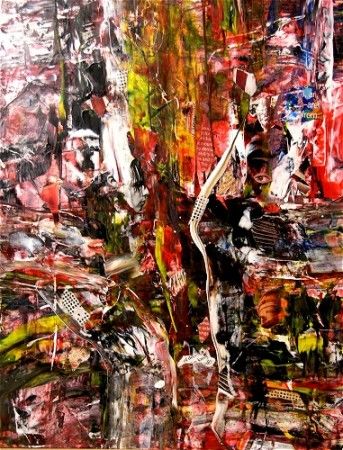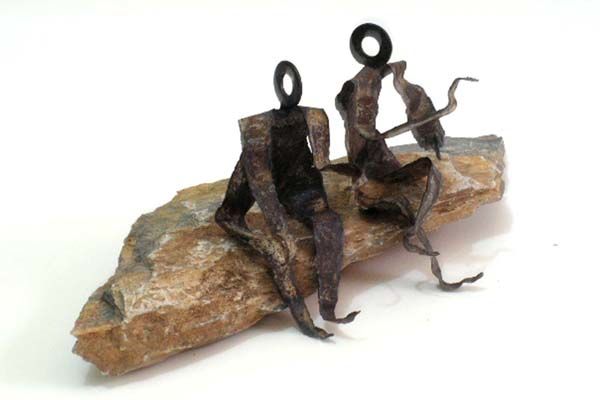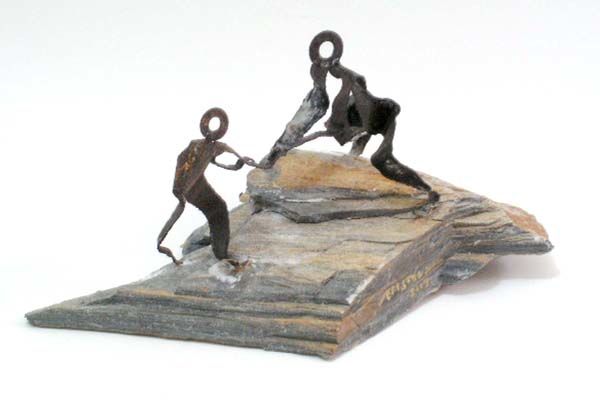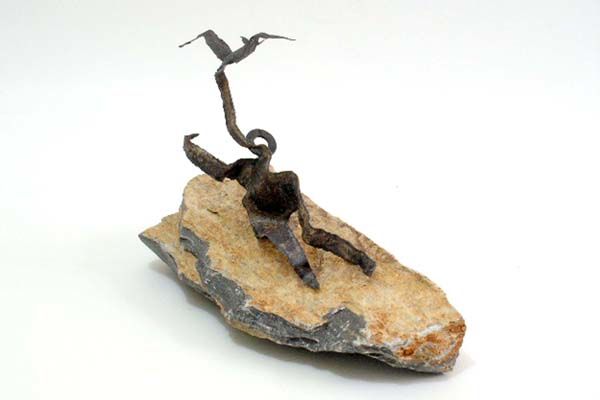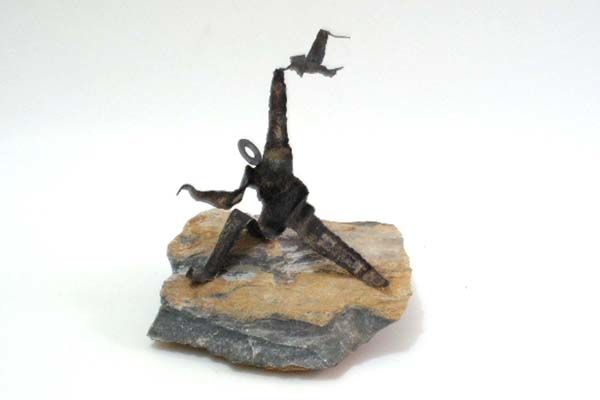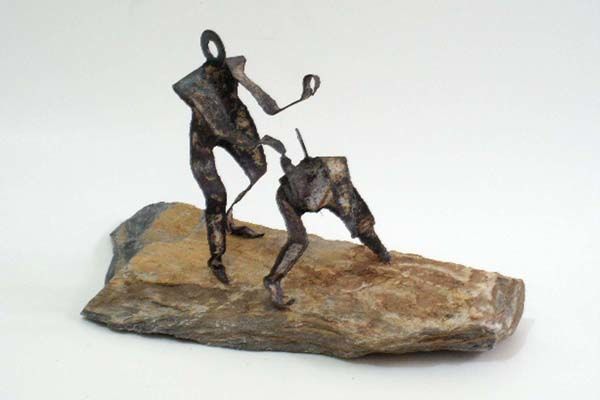Frederick Epistola
• Frederick Epistola is a compulsive but ingenious visual artist who has a proclivity to disregard traditional doctrines of art. A cosmopolitan, and influenced by early German expressionist painters, as well as, by the American abstract expressionist movement in the 1950s as exemplified by works of Wilhelm De Kooning and Jackson Pollock, his art is an abandonment of traditional ideas of composition, expressing a desire to liberate while at the same time restraining the imagery within the confines of a given space. Not letting his dyslexia hold him back, Epistola concentrated on perfecting his strokes and technique, thus projecting a mastery of both intuition and control in his artworks.
Epistola’s work is a product of vision, emotion, thoughts and juxtaposition of object, color and texture, all of which dwell on the remarkable consistent themes of existence and universality; on two persistent subjects: life and emotions; and on certain moods: concealing and revealing. By integrating spontaneous imagery with philosophies and confining them into small frames and spaces, Epistola leads viewers to look closely and become sensually involved in the artwork’s textures and colors.
In 2006, two of his works were included in the permanent collection of the prestigious International Museum of Collage, Assemblage and Construction based in Texas, USA. In 2008, his work has been featured in the Limited Edition Art Calendar of the Painters for Human Rights which was distributed internationally. He is the first Asian to achieve such feats. Known to be a social artist, Epistola’s works can also be found in the collection of the Painters for Human Rights in Florida, USA and Union of Young Peace builders based in Switzerland. In 2010, his work “ After the Rubble“ which formed part of the Doodle for Haiti exhibit was auctioned off at the Accademia dello Scarabocchio in Matera, Italy to raise funds for the Haiti flood victims.
Experimenting continually, Epistola in 2007 tried his hand at other materials, primarily steel and stone, and created his very first collection of metal sculptures. Calling himself a “socio- realist” sculptor, Epistola does not focus on appearances, which tells of his sculptures not depicting people and events but showing ideas and emotions. At their best, his works brim with movement and tension—all representations of man’s interaction with society and his struggle with everyday life. Using heat and taking advantage of the metal’s malleability, Epistola tries to bring out the personality, emotion and inner essence of a particular subject in his sculptures.
Sponsored by Mercedes-Benz Malaysia in 2008, Epistola successfully held a one-man show entitled Global Compact: Helping Improve Lives through a Fusion of Art and Technology at the Kuala Lumpur Performing Arts Center-Malaysia. He is currently preparing for a second run of the Global Compact exhibit with Mercedes-Benz Club Philippines this December 2010.
Drawn to Flu...
Discover contemporary artworks by Frederick Epistola, browse recent artworks and buy online. Categories: contemporary filipino artists. Artistic domains: Painting, Collages. Account type: Artist , member since 2005 (Country of origin Philippines). Buy Frederick Epistola's latest works on ArtMajeur: Discover great art by contemporary artist Frederick Epistola. Browse artworks, buy original art or high end prints.

Artist Value, Biography, Artist's studio:
JEJEMON ICONS • 10 artworks
View allART FROM HISTORY • 10 artworks
View allTHEORY OF RELATIVITY (Acrylic on Canvass) • 10 artworks
View allTHEORY OF RELATIVITY (SCULPTURE) • 10 artworks
View allEPISTOLA'S THEORY OF RELATIVITY • 10 artworks
View allLIFE SERIES 2006 • 10 artworks
View allSTARBUCKS COLLECTION • 10 artworks
View allPOLITICAL TRANSFIGURATION • 10 artworks
View allREMINISCE • 10 artworks
View allQUEST FOR MEANING • 10 artworks
View allSold Artworks • 56 artworks
Recognition
Biography
• Frederick Epistola is a compulsive but ingenious visual artist who has a proclivity to disregard traditional doctrines of art. A cosmopolitan, and influenced by early German expressionist painters, as well as, by the American abstract expressionist movement in the 1950s as exemplified by works of Wilhelm De Kooning and Jackson Pollock, his art is an abandonment of traditional ideas of composition, expressing a desire to liberate while at the same time restraining the imagery within the confines of a given space. Not letting his dyslexia hold him back, Epistola concentrated on perfecting his strokes and technique, thus projecting a mastery of both intuition and control in his artworks.
Epistola’s work is a product of vision, emotion, thoughts and juxtaposition of object, color and texture, all of which dwell on the remarkable consistent themes of existence and universality; on two persistent subjects: life and emotions; and on certain moods: concealing and revealing. By integrating spontaneous imagery with philosophies and confining them into small frames and spaces, Epistola leads viewers to look closely and become sensually involved in the artwork’s textures and colors.
In 2006, two of his works were included in the permanent collection of the prestigious International Museum of Collage, Assemblage and Construction based in Texas, USA. In 2008, his work has been featured in the Limited Edition Art Calendar of the Painters for Human Rights which was distributed internationally. He is the first Asian to achieve such feats. Known to be a social artist, Epistola’s works can also be found in the collection of the Painters for Human Rights in Florida, USA and Union of Young Peace builders based in Switzerland. In 2010, his work “ After the Rubble“ which formed part of the Doodle for Haiti exhibit was auctioned off at the Accademia dello Scarabocchio in Matera, Italy to raise funds for the Haiti flood victims.
Experimenting continually, Epistola in 2007 tried his hand at other materials, primarily steel and stone, and created his very first collection of metal sculptures. Calling himself a “socio- realist” sculptor, Epistola does not focus on appearances, which tells of his sculptures not depicting people and events but showing ideas and emotions. At their best, his works brim with movement and tension—all representations of man’s interaction with society and his struggle with everyday life. Using heat and taking advantage of the metal’s malleability, Epistola tries to bring out the personality, emotion and inner essence of a particular subject in his sculptures.
Sponsored by Mercedes-Benz Malaysia in 2008, Epistola successfully held a one-man show entitled Global Compact: Helping Improve Lives through a Fusion of Art and Technology at the Kuala Lumpur Performing Arts Center-Malaysia. He is currently preparing for a second run of the Global Compact exhibit with Mercedes-Benz Club Philippines this December 2010.
Drawn to Flu...
-
Nationality:
PHILIPPINES

- Date of birth : 1973
- Artistic domains:
- Groups: Contemporary Filipino Artists
Ongoing and Upcoming art events
Influences
Education
Artist value certified
Achievements
Activity on ArtMajeur
Latest News
All the latest news from contemporary artist Frederick Epistola
Art Observation Tours
1999 National Museum of Australia, Canberra, Australia
1999 Melbourne Museum, Melbourne, Australia
Art Observation Tour in Paris, France
2002 Le Louvre Museum, Paris, France (Sponsored by the Office o the President o the Republic o the Philippines)
Art Observation Tour in St. Petersburg, Russia
2003 The State Hermitage Museum, St. Petersburg., Russia (Sponsored by the Office of the President, Republic o the Philippines)
International Art Project (Mandala Project) Vilnius Lithuania
2000 World Youth Festival, Vilnius, Lithuania (Sponsored by the City Government o Parañaque City)
International Art Project (Cildren Now! Project - World Youth Forum 2002)
2002 World Youth Forum, Krakow, Poland
International Art Project
2000 International Conference on Ecological Education, Olomouc City, Czech Republic
Art Observation Tour in Strasbourg, France
2002 The Musee d'art Moderne et Contemporain de Strasbourg, Strasbourg, France (Sponsored by the Office of the President, Republic of the Philippines)
About Frederick Epistola
• Frederick Epistola is a compulsive but ingenious visual artist who has a proclivity to disregard traditional doctrines of art. A cosmopolitan, and influenced by early German expressionist painters, as well as, by the American abstract expressionist movement in the 1950s as exemplified by works of Wilhelm De Kooning and Jackson Pollock, his art is an abandonment of traditional ideas of composition, expressing a desire to liberate while at the same time restraining the imagery within the confines of a given space. Not letting his dyslexia hold him back, Epistola concentrated on perfecting his strokes and technique, thus projecting a mastery of both intuition and control in his artworks.
Epistola’s work is a product of vision, emotion, thoughts and juxtaposition of object, color and texture, all of which dwell on the remarkable consistent themes of existence and universality; on two persistent subjects: life and emotions; and on certain moods: concealing and revealing. By integrating spontaneous imagery with philosophies and confining them into small frames and spaces, Epistola leads viewers to look closely and become sensually involved in the artwork’s textures and colors.
In 2006, two of his works were included in the permanent collection of the prestigious International Museum of Collage, Assemblage and Construction based in Texas, USA. In 2008, his work has been featured in the Limited Edition Art Calendar of the Painters for Human Rights which was distributed internationally. He is the first Asian to achieve such feats. Known to be a social artist, Epistola’s works can also be found in the collection of the Painters for Human Rights in Florida, USA and Union of Young Peace builders based in Switzerland. In 2010, his work “ After the Rubble“ which formed part of the Doodle for Haiti exhibit was auctioned off at the Accademia dello Scarabocchio in Matera, Italy to raise funds for the Haiti flood victims.
Experimenting continually, Epistola in 2007 tried his hand at other materials, primarily steel and stone, and created his very first collection of metal sculptures. Calling himself a “socio- realist” sculptor, Epistola does not focus on appearances, which tells of his sculptures not depicting people and events but showing ideas and emotions. At their best, his works brim with movement and tension—all representations of man’s interaction with society and his struggle with everyday life. Using heat and taking advantage of the metal’s malleability, Epistola tries to bring out the personality, emotion and inner essence of a particular subject in his sculptures.
Sponsored by Mercedes-Benz Malaysia in 2008, Epistola successfully held a one-man show entitled Global Compact: Helping Improve Lives through a Fusion of Art and Technology at the Kuala Lumpur Performing Arts Center-Malaysia. He is currently preparing for a second run of the Global Compact exhibit with Mercedes-Benz Club Philippines this December 2010.
Drawn to Fluxus—an art movement which originated in the 1960s and mixes the ideals of the Dada, Bauhaus and the Zen movements—Epistola, through the influence of renowned mixed media artist Cecil Touchon and Keith Buchholz , further honed his skills and talents in mixed media by incorporating the cultural, political and sociological aspects of everyday living into his art. By taking things out of their contexts and rearranging them in interesting ways, Epistola, with his spontaneity and expressive approach to art, strives to create masterpieces which focus on culture, creativity, and the human consciousness. Among his notable exhibits are: “Miniature Masterpieces” (September 2010), Gallery 2929 ASWARA, National Academy of Arts, Culture and Heritage, Kuala Lumpur, Malaysia; “Fluxus Amusements, Diversions, Games, Tricks and Puzzles” (October 2010), FLUX MUSEUM, Fort Worth, Texas, USA; “NO COMMERCIAL POTENTIAL” (2010), Venezia , Italy; and “Projet d'Art Postal: World without Water” (2010), ARTOTEM, Ouistreham, France.
Frederick Epistola earned his Bachelor’s Degree in Fine Arts, Major in Visual Communications in 1996 at the University of the Philippines. He is a member of the Global Collage Movement based in the United States and the international group Open Fluxus. His book― Captured Culture: An Interpretative Portrait of Parañaque City was launched in February 2007.
Article
My works are imageries of ideas- ethereal and mundane; emotions- intense and vibrant; and experiences, all of which are conveyed through spontaneous strokes. In my attempt to stretch the boundaries of what I can do with paint, I used colors which determine my mood and the intensity of my emotions. All of my works are intimate and personal to me, thus confined within the walls of a quad.
EPISTOLA’S THEORY OF RELATIVITY
THE ART HALL, Tower 2, The Enterprise Center, 6766 Ayala Avenue cor. Paseo De Roxas Sts., Makati City (23 July to 5 August 2007)
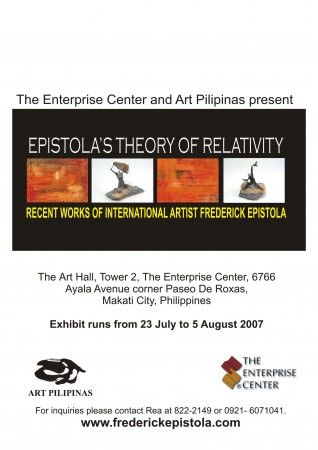
Parañaque artist exhibits at the International Museum of Collage
This month yet another Filipino has done his country proud. He is the abstract expressionist and collage artist, Frederick B. Epistola, who hails from Parañaque City, and has two of his works collected by the prestigious International Museum of Collage, Assemblage and Construction (IMCAC) based in Texas, USA. Done in mixed media, the pieces are entitled Psycological Procreation and Psycological Procreation #2.
To date he is the first and only Asian collagist who has works exhibited at IMCAC.
Featured in , he says of his art: "My works are imageries of ideas—ethereal and mundane; emotions—intense and vibrant; and experiences, all of which are conveyed through spontaneous strokes. In my attempt to stretch the boundaries of what I can do with paint, I used colors, which determine my mood and the intensity of my emotions. All of my works are intimate and personal to me, thus confined within the walls of a quad.
Still from the same website, the artist is described as a "compulsive but ingenious painter who has a proclivity to disregard traditional doctrines of paintings." He names as his most significant influences the early German expressionist painters and the American abstract expressionist movement in the 1950s as exemplified by works of Willem De Kooning and Jackson Pollock.
A graduate of Fine Arts, majoring in Visual Communications at the University of the Philippines, Epistola’s works are scattered in the Philippines as well as in private collections in Australia, New York, Czech Republic, Lithuania, Poland, Germany, France, Russia and Thailand.
He is chairman of the Global Art Project for Children, Children NOW!, and also the director general of Unesco Club in the country.
Epistola is working on a new series of works for exhibition in Europe.
